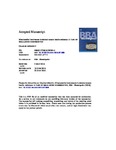Mitochondrial involvement in skeletal muscle insulin resistance – a case of imbalanced bioenergetics
| dc.contributor.author | Affourtit, C | |
| dc.date.accessioned | 2016-08-03T10:04:59Z | |
| dc.date.issued | 2016-10-01 | |
| dc.identifier.issn | 0005-2728 | |
| dc.identifier.issn | 0006-3002 | |
| dc.identifier.uri | http://hdl.handle.net/10026.1/5171 | |
| dc.description.abstract |
Skeletal muscle insulin resistance in obesity associates with mitochondrial dysfunction, but the causality of this association is controversial. This review evaluates mitochondrial models of nutrient-induced muscle insulin resistance. It transpires that all models predict that insulin resistance arises as a result of imbalanced cellular bioenergetics. The nature and precise origin of the proposed insulin-numbing molecules differ between models but all species only accumulate when metabolic fuel supply outweighs energy demand. This observation suggests that mitochondrial deficiency in muscle insulin resistance is not merely owing to intrinsic functional defects, but could instead be an adaptation to nutrient-induced changes in energy expenditure. Such adaptive effects are likely because muscle ATP supply is fully driven by energy demand. This market-economic control of myocellular bioenergetics offers a mechanism by which insulin-signalling deficiency can cause apparent mitochondrial dysfunction, as insulin resistance lowers skeletal muscle anabolism and thus dampens ATP demand and, consequently, oxidative ATP synthesis. | |
| dc.format.extent | 1678-1693 | |
| dc.format.medium | Print-Electronic | |
| dc.language | en | |
| dc.language.iso | en | |
| dc.publisher | Elsevier BV | |
| dc.subject | Muscle insulin sensitivity | |
| dc.subject | Mitochondria | |
| dc.subject | Oxidative phosphorylation | |
| dc.subject | Reactive oxygen species | |
| dc.subject | ATP turnover | |
| dc.subject | Control of cellular bioenergetics | |
| dc.title | Mitochondrial involvement in skeletal muscle insulin resistance – a case of imbalanced bioenergetics | |
| dc.type | journal-article | |
| dc.type | Review | |
| plymouth.author-url | https://www.ncbi.nlm.nih.gov/pubmed/27473535 | |
| plymouth.issue | 10 | |
| plymouth.volume | 1857 | |
| plymouth.publication-status | Published | |
| plymouth.journal | BBA - Bioenergetics | |
| dc.identifier.doi | 10.1016/j.bbabio.2016.07.008 | |
| plymouth.organisational-group | /Plymouth | |
| plymouth.organisational-group | /Plymouth/Faculty of Health | |
| plymouth.organisational-group | /Plymouth/Faculty of Health/School of Biomedical Sciences | |
| plymouth.organisational-group | /Plymouth/REF 2021 Researchers by UoA | |
| plymouth.organisational-group | /Plymouth/REF 2021 Researchers by UoA/UoA01 Clinical Medicine | |
| plymouth.organisational-group | /Plymouth/Research Groups | |
| plymouth.organisational-group | /Plymouth/Research Groups/Institute of Translational and Stratified Medicine (ITSMED) | |
| plymouth.organisational-group | /Plymouth/Research Groups/Institute of Translational and Stratified Medicine (ITSMED)/CBR | |
| plymouth.organisational-group | /Plymouth/Users by role | |
| plymouth.organisational-group | /Plymouth/Users by role/Academics | |
| dc.publisher.place | Netherlands | |
| dcterms.dateAccepted | 2016-07-23 | |
| dc.rights.embargodate | 2017-7-26 | |
| dc.identifier.eissn | 0006-3002 | |
| dc.rights.embargoperiod | 12 months | |
| rioxxterms.versionofrecord | 10.1016/j.bbabio.2016.07.008 | |
| rioxxterms.licenseref.uri | http://www.rioxx.net/licenses/under-embargo-all-rights-reserved | |
| rioxxterms.licenseref.startdate | 2016-10-01 | |
| rioxxterms.type | Journal Article/Review | |
| plymouth.funder | Why do pancreatic beta cells waste energy?::MRC |


